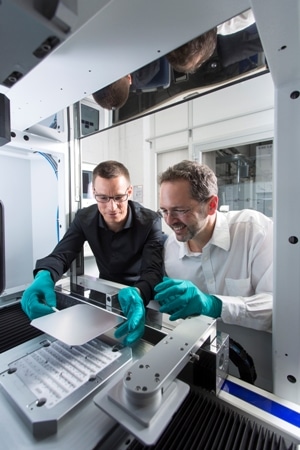May 12 2016
A laser-based manufacturing process from the Fraunhofer ISE in Freiburg, Germany is revolutionizing the photovoltaics market. For the first time point-contacted solar cells can be manufactured in series. Several million cells with significantly higher efficiency levels are already on the market.
 Dr. Jan Nekarda and Dr.-Ing. Ralf Preu (from the left) developed the Laser Fired Contact process for series manufacturing of highly efficient PERC solar cells. (© Photo Dirk Mahler/Fraunhofer)
Dr. Jan Nekarda and Dr.-Ing. Ralf Preu (from the left) developed the Laser Fired Contact process for series manufacturing of highly efficient PERC solar cells. (© Photo Dirk Mahler/Fraunhofer)
The transformation of our energy system towards the goal of more electricity from renewable energy sources is one of the major challenges facing our society for the upcoming decades. Solar technology will play a decisive role in reaching that goal. »The total amount of electric energy from photovoltaic sources is more than 250 terawatt hours, approximately equivalent to the amount produced by 30 nuclear power plants. In order to help meet international climate objectives, the amount of photovoltaic power newly installed each year will have to increase by ten times over the next 15 years. On the whole, solar technology will have to become more efficient and cost-effective in order to meet the demands of this market,« explains Dr.-Ing. Ralf Preu, Director of the Division‚ PV Production Technology and Quality Assurance, at the Fraunhofer Institute for Solar Energy Systems ISE in Freiburg. The researcher and his colleague Dr. Jan Nekarda have already made an important contribution to climate protection with the development of Laser-Fired Contact (LFC) technology, enabling the manufacture of more efficient solar cells at lower cost.
Today most solar cells are equipped with a wide-surface metallic contact, covering the entire backside of the silicon wafer and allowing electricity to flow from the cell to the electrode. This configuration however limits efficiency. A more high-performance alternative, discovered in 1989, is the Passivated Emitter and Rear Cell technology (PERC). In contrast to conventional cells, this technology includes an additional reflective layer on the backside of the cell and thousands of electric contact points. The LFC process developed by the Fraunhofer researchers has enabled the first industrial mass production of PERC solar cells.
Series Production of Highly Efficient Cells
A very thin non-conductive layer is deposited on the underside of a PERC solar cell between the contact layer and the wafer. Acting as a mirror, this layer reflects the share of sunlight not absorbed when penetrating the wafer back into the silicon wafer. Since the front side also reflects this light back into the wafer, it is also captured in the silicon wafer and the efficiency level of the solar cell increases. Drawing the electricity from the wafer requires many small apertures in the non-conductive layer in order to establish contact between the electrode metal and the silicon wafer. The LFC procedure creates each of these approximately 100,000 contacts per wafer with a single laser pulse. »The challenge was to coordinate the pulses in such a way that contact is completely established, while damage to the silicon is kept to minimal levels. Here it‘s crucial that the laser light effect is limited to between 50 and 2,000 nanoseconds,« explains Dr. Jan Nekarda, group manager at the Fraunhofer ISE. An innovative system for guiding the laser beams makes it possible to create all the contacts in approximately one second.
»PERC solar cells made this way have an improved efficiency level of one percent absolute. With today‘s solar cell efficiency of approximately 20 percent, that‘s about five percent relative. We gain an additional two percent in the system, which means we increase the overall energy yield by seven percent,« Ralf Preu is happy to report. The efficiency level is of enormous importance since the majority of costs in photovoltaics are directly proportional to surface area. »Where we need 100 square meters of solar cells today, in the future we‘ll only need 93 square meters to produce the same amount of electricity. This not only means less silicon, but also less module material, less material in the systems and ultimately also savings in terms of planning costs.«
Successful Implementation in Industry
Solar cell manufacturers can easily and inexpensively integrate the laser procedure in existing production processes. According to company information, Hanwha Q Cells has already made 20 million cells – using LFC technology since beginning production. Companies around the world have in the meantime put PERC technology into mass production. »In the current year alone manufacturers have invested more than 200 million Euro in the implementation. This finally means the establishment of the next evolutionary stage of the silicon solar cell,« Ralf Preu is excited to report.
Ralf Preu and Jan Nekarda have received the 2016 Joseph-von-Fraunhofer prize for their role as initiators and drivers of this change. The jury based the award among other things on the fact that »the researchers‘ development helps German companies continue to succeed in the highly competitive photovoltaics market.«